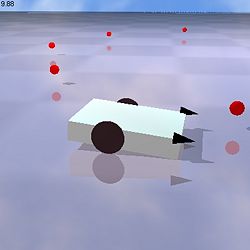Artificial life
Artificial life (commonly Alife or alife) is a field of study and an associated art form which examine systems related to life, its processes, and its evolution through simulations using computer models, robotics, and biochemistry.[1] There are three main kinds of alife[2], named for their approaches: soft[3], from software; hard, from hardware; and wet, from biochemistry. Artificial life imitates traditional biology by trying to recreate biological phenomena.[4] The term "artificial life" is often used to specifically refer to soft alife.[5]

Contents |
Overview
Artificial life studies the logic of living systems in artificial environments. The goal is to study the phenomena of living systems in order to come to an understanding of the complex information processing that defines such systems.
Also sometimes included in the umbrella term Artificial Life are agent based systems which are used to study the emergent properties of societies of agents.
Philosophy
At present, the commonly accepted definition of life does not consider any current alife simulations and softwares to be alive, and they do not constitute part of the evolutionary process of any ecosystem. However, different opinions about artificial life's potential have arisen:
- The strong alife (cf. Strong AI) position states that "life is a process which can be abstracted away from any particular medium" (John von Neumann). Notably, Tom Ray declared that his program Tierra is not simulating life in a computer but synthesizing it.
- The weak alife position denies the possibility of generating a "living process" outside of a chemical solution. Its researchers try instead to simulate life processes to understand the underlying mechanics of biological phenomena.
Organizations
Techniques
- Cellular automata were used in the early days of artificial life, and they are still often used for ease of scalability and parallelization. Alife and cellular automata share a closely tied history.
- Neural networks are sometimes used to model the brain of an agent. Although traditionally more of an artificial intelligence technique, neural nets can be important for simulating population dynamics of organisms that can learn. The symbiosis between learning and evolution is central to theories about the development of instincts in organisms with higher neurological complexity, as in, for instance, the Baldwin effect.
Related subjects
- Artificial intelligence has traditionally used a top down approach, while alife generally works from the bottom up. [6]
- Artificial chemistry started as a method within the alife community to abstract the processes of chemical reactions.
- Evolutionary algorithms are a practical application of the weak alife principle applied to optimization problems. Many optimization algorithms have been crafted which borrow from or closely mirror alife techniques. The primary difference lies in explicitly defining the fitness of an agent by its ability to solve a problem, instead of its ability to find food, reproduce, or avoid death. The following is a list of evolutionary algorithms closely related to and used in alife:
- Ant colony optimization
- Evolutionary algorithm
- Genetic algorithm
- Genetic programming
- Swarm intelligence
- Evolutionary art uses techniques and methods from artificial life to create new forms of art.
- Evolutionary music uses similar techniques, but applied to music instead of visual art.
History
Criticism
Alife has had a controversial history. John Maynard Smith criticized certain artificial life work in 1994 as "fact-free science".[7] However, the recent publication of artificial life articles in widely read journals such as Science and Nature is evidence that artificial life techniques are becoming more accepted in the mainstream, at least as a method of studying evolution.[8]
Notable simulators
This is a list of Artificial life/Digital organism simulators, organized by the method of creature definition.
Program-based
These contain organisms with a complex DNA language, usually Turing complete. This language is more often in the form of a computer program than actual biological DNA. Assembly derivatives are the most common languages used. Use of cellular automata is common but not required.
- Avida
- breve (actually a multi-purpose simulation environment)
- Darwinbots
- Evolve 4.0
- Framsticks
- Tierra
- Micropond
Module-based
Individual modules are added to a creature. These modules modify the creature's behaviors and characteristics either directly, by hard coding into the simulation (leg type A increases speed and metabolism), or indirectly, through the emergent interactions between a creature's modules (leg type A moves up and down with a frequency of X, which interacts with other legs to create motion). Generally these are simulators which emphasize user creation and accessibility over mutation and evolution.
- TechnoSphere
Parameter-based
Organisms are generally constructed with pre-defined and fixed behaviors that are controlled by various parameters that mutate. That is, each organism contains a collection of numbers or other finite parameters. Each parameter controls one or several aspects of an organism in a well-defined way.
- Kyresoo Plants
Neural net–based
These simulations have creatures that learn and grow using neural nets or a close derivative. Emphasis is often, although not always, more on learning than on natural selection.
- Creatures (a game)
- Noble Ape
- Polyworld
See also
- Life simulation game
- Autonomous foraging
- Artificial life organizations
- Complex adaptive system
- Darwin machine
- Social simulation
- Synthetic life
- Mathematical biology
References
- ↑ "Dictionary.com definition". Retrieved on 2007-01-19.
- ↑ Mark A. Bedau (November 2003). "Artificial life: organization, adaptation and complexity from the bottom up" (PDF). TRENDS in Cognitive Sciences. Retrieved on 2007-01-19.
- ↑ Andrew Adamatzky and Maciej Komosinski (2005). Artificial Life Models in Software. New York: Springer-Verlag. ISBN 978-1-85233-945-6. http://www.springeronline.com/sgw/cda/frontpage/0,11855,5-40109-22-39144451-0,00.html. Retrieved on 2007-01-19.
- ↑ Christopher Langton. "What is Artificial Life?". Retrieved on 2007-01-19.
- ↑ John Johnston, (2008) "The Allure of Machinic Life: Cybernetics, Artificial Life, and the New AI", MIT Press
- ↑ "AI Beyond Computer Games". Retrieved on 2008-07-04.
- ↑ Horgan, J. 1995. From Complexity to Perplexity. Scientific American. p107
- ↑ "Evolution experiments with digital organisms". Retrieved on 2007-01-19.
External links
|
||||||||||||||||||||||||||||||||||||||||||||